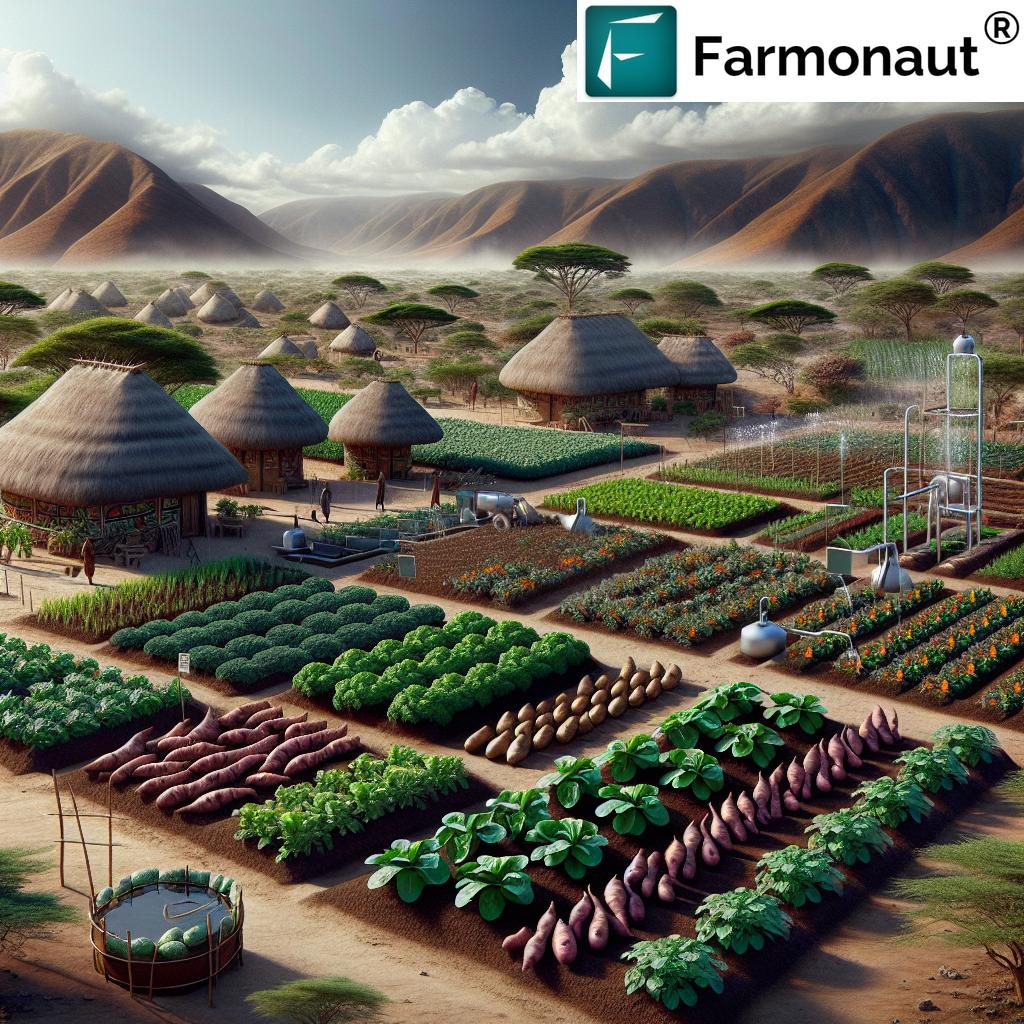Boosting Kenya’s Agriculture: How Sustainable Practices Are Transforming Soil Health and Crop Yields
“Sustainable agriculture practices in Kenya have transformed hectares of barren farmland, significantly increasing crop yields for smallholder farmers.”
In the heart of East Africa, Kenya’s agricultural landscape is undergoing a remarkable transformation. As climate change threatens food security and livelihoods, innovative sustainable practices are emerging as powerful tools to revitalize soil health and boost crop yields. In this comprehensive exploration, we’ll delve into how these practices are reshaping Kenya’s agricultural sector, empowering smallholder farmers, and paving the way for a more resilient future.
The Challenge: Climate Change and Soil Degradation
Kenya, like many African nations, relies heavily on agriculture as a cornerstone of its economy. However, unpredictable weather patterns and soil degradation have posed significant challenges to farmers across the country. Erratic rainfall, prolonged droughts, and intense heat waves have led to widespread crop failures and food insecurity. Moreover, years of intensive farming without proper soil management have left vast tracts of land barren and unproductive.
In response to these challenges, a groundbreaking initiative known as the Cross Soil Project was launched in 2015 by the German Agency for International Cooperation (GIZ). This project aimed to address the pressing issues facing Kenya’s agricultural sector by providing essential training and resources to smallholder farmers.
The Cross Soil Project: A Catalyst for Change
The Cross Soil Project, which ran from 2015 to 2023, has been a game-changer for Kenya’s agricultural landscape. Let’s look at some of the key achievements:
- 119,808 farmers from 46,080 households benefited from the project
- 38,755 hectares of farmland were rehabilitated
- 37% increase in yields of staple crops like maize and beans on treated plots
- 2,010 farmer groups and water resource user associations trained in sustainable land management and agroecological practices
These impressive figures underscore the project’s success in revitalizing Kenya’s agricultural sector. But what specific practices and techniques have led to such remarkable results?
Sustainable Agriculture Practices Transforming Kenyan Farms
“Agroecological farming methods in Kenya are addressing soil acidity and enhancing nutrient content, boosting productivity of staple crops like maize and beans.”
The Cross Soil Project introduced a range of sustainable agriculture practices that have proven highly effective in rehabilitating degraded lands and boosting crop yields. Let’s explore some of these innovative techniques:
1. Terracing: Combating Erosion and Enhancing Soil Health
Terracing has emerged as a critical strategy in Kenya’s fight against soil erosion. By creating level platforms on hillsides, terraces effectively reduce water runoff and soil loss. This practice not only conserves precious topsoil but also improves water infiltration, allowing crops to access moisture even during dry spells.
Benefits of terracing include:
- Reduced soil erosion by up to 90%
- Increased water retention in the soil
- Enhanced nutrient availability for crops
- Improved crop yields on sloped lands
2. Organic Farming: Nurturing Soil Health Naturally
The project placed a strong emphasis on organic farming practices, encouraging farmers to use natural materials to enrich their soil. This approach not only improves soil structure and fertility but also promotes long-term sustainability.
Key organic farming techniques introduced include:
- Composting: Converting farm waste into nutrient-rich soil amendments
- Green manuring: Planting cover crops to add organic matter to the soil
- Crop rotation: Alternating crops to maintain soil fertility and break pest cycles
- Mulching: Using organic materials to conserve soil moisture and suppress weeds
3. Water Conservation: Maximizing Limited Resources
In a country prone to droughts, effective water management is crucial. The Cross Soil Project introduced several water conservation techniques to help farmers make the most of limited water resources:
- Rainwater harvesting: Collecting and storing rainwater for use during dry periods
- Drip irrigation: Delivering water directly to plant roots, minimizing waste
- Contour plowing: Creating furrows that follow the land’s natural contours to reduce runoff
- Water-efficient crop varieties: Introducing drought-resistant crops that thrive with less water
These practices have not only helped farmers weather dry spells but have also contributed to more efficient use of water resources across Kenya’s agricultural sector.
4. Agroforestry: Integrating Trees for Sustainable Farming
Agroforestry, the practice of integrating trees and shrubs into crop and animal farming systems, has proven to be a powerful tool in Kenya’s sustainable agriculture toolkit. This approach offers multiple benefits:
- Soil improvement through leaf litter and root systems
- Enhanced biodiversity and ecosystem services
- Additional income streams from tree products (fruit, timber, etc.)
- Carbon sequestration, contributing to climate change mitigation
Farmers participating in the Cross Soil Project learned to strategically plant trees alongside their crops, creating more resilient and productive agricultural systems.
5. Conservation Agriculture: Minimum Tillage for Maximum Results
Conservation agriculture practices, such as minimum tillage and intercropping, have been widely adopted through the project. These techniques help to:
- Reduce soil disturbance and maintain soil structure
- Increase soil organic matter content
- Improve water infiltration and retention
- Reduce labor and fuel costs associated with intensive tillage
By implementing these practices, Kenyan farmers have seen significant improvements in soil health and crop productivity, even in the face of challenging weather conditions.
Addressing Soil Acidity and Nutrient Depletion
One of the most pressing issues facing Kenyan farmers was the widespread problem of soil acidity and nutrient depletion. The Cross Soil Project tackled this challenge head-on through a combination of soil testing and targeted interventions.
Soil Testing and Analysis
Comprehensive soil testing in regions like Western Kenya revealed severe soil degradation characterized by high acidity and nutrient depletion. Armed with this knowledge, project leaders were able to develop tailored solutions for different areas.
Lime Application
To combat soil acidity, farmers were trained in the proper application of agricultural lime. This practice helps to:
- Raise soil pH to optimal levels for crop growth
- Improve nutrient availability in the soil
- Enhance the effectiveness of fertilizers
- Promote beneficial soil microorganism activity
Organic Fertilizers and Soil Amendments
In addition to lime, farmers learned to use a variety of organic fertilizers and soil amendments to replenish depleted nutrients. These included:
- Compost and well-rotted manure
- Bone meal and fish emulsion for phosphorus and nitrogen
- Rock dust for trace minerals
- Leguminous cover crops to fix nitrogen in the soil
By addressing soil acidity and nutrient deficiencies, farmers were able to create a more favorable environment for crop growth, leading to significant increases in yields.

Climate Change Mitigation Through Sustainable Farming
While the primary goal of the Cross Soil Project was to improve agricultural productivity, the sustainable practices introduced also contribute significantly to climate change mitigation. Here’s how:
- Carbon Sequestration: Practices like agroforestry and conservation agriculture help to sequester carbon in the soil and biomass, reducing greenhouse gas concentrations in the atmosphere.
- Reduced Emissions: Minimal tillage and efficient fertilizer use lead to lower emissions of carbon dioxide and nitrous oxide from agricultural activities.
- Enhanced Resilience: By improving soil health and water retention, these practices make farms more resilient to climate shocks, reducing the need for carbon-intensive interventions during extreme weather events.
- Biodiversity Conservation: Sustainable farming methods promote biodiversity, which plays a crucial role in maintaining ecosystem balance and mitigating climate change impacts.
As Kenya continues to grapple with the effects of climate change, these sustainable agricultural practices offer a pathway to both adaptation and mitigation.
The Role of Technology in Sustainable Agriculture
While the Cross Soil Project focused primarily on traditional sustainable practices, it’s worth noting the growing role of technology in advancing sustainable agriculture in Kenya and beyond. Companies like Farmonaut are at the forefront of this technological revolution, offering innovative solutions to support farmers in their sustainability efforts.
Farmonaut leverages satellite technology and artificial intelligence to provide farmers with valuable insights into crop health, soil moisture levels, and other critical metrics. This data-driven approach complements the sustainable practices introduced by projects like Cross Soil, enabling farmers to make even more informed decisions about resource management and crop cultivation.
Some key features of Farmonaut’s technology include:
- Real-time crop health monitoring using multispectral satellite imagery
- AI-powered advisory systems for personalized farm management recommendations
- Blockchain-based traceability solutions for supply chain transparency
- Carbon footprint tracking to support environmental sustainability efforts
By integrating these technological solutions with sustainable farming practices, Kenyan farmers can further optimize their operations and contribute to a more sustainable and productive agricultural sector.
Comparative Analysis: Traditional vs. Sustainable Agricultural Practices in Kenya
| Agricultural Aspect | Traditional Methods | Sustainable Practices | Estimated Impact on Crop Yield (%) | Environmental Benefits |
|---|---|---|---|---|
| Soil Health Management | Minimal soil testing, overuse of chemical fertilizers | Regular soil testing, balanced use of organic and inorganic fertilizers | +25-30% | Improved soil structure, increased biodiversity |
| Erosion Prevention | Limited use of erosion control measures | Terracing, contour plowing, cover cropping | +15-20% | Reduced soil loss, improved water retention |
| Water Usage | Flood irrigation, rain-dependent farming | Drip irrigation, rainwater harvesting, drought-resistant crops | +20-25% | Water conservation, reduced runoff |
| Fertilizer Application | Heavy reliance on synthetic fertilizers | Integrated nutrient management, use of organic fertilizers | +10-15% | Reduced chemical runoff, improved soil health |
| Pest Management | Primarily chemical pesticides | Integrated Pest Management (IPM), biological control | +5-10% | Reduced chemical use, preserved beneficial insects |
| Crop Diversity | Monoculture farming | Crop rotation, intercropping, agroforestry | +15-20% | Enhanced biodiversity, improved soil fertility |
This table clearly illustrates the significant advantages of sustainable agricultural practices over traditional methods in terms of both crop yield and environmental benefits. By adopting these sustainable approaches, Kenyan farmers are not only increasing their productivity but also contributing to the long-term health of their land and the surrounding ecosystem.
The Path Forward: Scaling Up Sustainable Agriculture in Kenya
The success of the Cross Soil Project demonstrates the immense potential of sustainable agriculture practices in transforming Kenya’s agricultural sector. However, to achieve lasting change on a national scale, several key steps are necessary:
- Continued Education and Training: Expanding farmer training programs to reach more rural communities and ensure widespread adoption of sustainable practices.
- Policy Support: Developing and implementing policies that incentivize sustainable farming methods and support smallholder farmers in transitioning to these practices.
- Investment in Infrastructure: Improving rural infrastructure, particularly water management systems and transportation networks, to support sustainable agriculture initiatives.
- Research and Innovation: Investing in agricultural research to develop new sustainable farming techniques and adapt existing methods to Kenya’s diverse agro-ecological zones.
- Market Access: Creating and strengthening market linkages for sustainably produced crops, ensuring fair prices for farmers and incentivizing continued adoption of these practices.
- Technology Integration: Leveraging technologies like those offered by Farmonaut to enhance the effectiveness of sustainable farming practices and provide data-driven insights to farmers.
By focusing on these areas, Kenya can build on the success of projects like Cross Soil and create a more resilient, productive, and sustainable agricultural sector.

The Global Implications of Kenya’s Agricultural Transformation
The success of sustainable agriculture practices in Kenya holds valuable lessons for other countries facing similar challenges. As climate change continues to threaten global food security, the strategies implemented in Kenya could serve as a model for sustainable agricultural development worldwide.
Key takeaways from Kenya’s experience include:
- The importance of tailored, locally-appropriate solutions
- The effectiveness of farmer-to-farmer knowledge transfer
- The potential for significant yield increases through sustainable practices
- The dual benefits of improved food security and climate change mitigation
As we look to the future, the transformation of Kenya’s agricultural sector through sustainable practices offers hope for a world grappling with the challenges of feeding a growing population in the face of climate change.
Conclusion: A Green Revolution for Kenya and Beyond
The story of Kenya’s agricultural transformation is one of resilience, innovation, and hope. Through the adoption of sustainable farming practices, smallholder farmers across the country are rehabilitating degraded lands, boosting crop yields, and contributing to climate change mitigation efforts.
As we’ve explored in this comprehensive overview, the success of initiatives like the Cross Soil Project demonstrates the power of sustainable agriculture to address some of the most pressing challenges facing our world today. By combining traditional wisdom with modern scientific knowledge and technological innovations, Kenya is charting a course towards a more sustainable and food-secure future.
The journey is far from over, but the progress made thus far is truly inspiring. As Kenya continues to expand and refine its sustainable agriculture practices, it offers valuable lessons and inspiration for countries around the world. Together, we can cultivate a future where sustainable farming nourishes both people and planet.
FAQs: Sustainable Agriculture in Kenya
- Q: What are the main challenges facing Kenyan farmers?
A: Kenyan farmers face challenges such as unpredictable weather patterns due to climate change, soil degradation, limited access to resources and training, and market fluctuations. - Q: How does terracing help in sustainable agriculture?
A: Terracing helps prevent soil erosion, improves water retention, and allows for better use of sloped land for agriculture, ultimately leading to improved crop yields. - Q: What is agroforestry, and how does it benefit farmers?
A: Agroforestry involves integrating trees into farming systems. It helps improve soil health, provides additional income through tree products, enhances biodiversity, and contributes to carbon sequestration. - Q: How do sustainable practices contribute to climate change mitigation?
A: Sustainable practices like conservation agriculture and agroforestry help sequester carbon in soil and biomass, reduce greenhouse gas emissions from farming activities, and enhance farm resilience to climate shocks. - Q: What role does technology play in sustainable agriculture in Kenya?
A: Technology, such as satellite-based crop monitoring and AI-powered advisory systems offered by companies like Farmonaut, helps farmers make data-driven decisions, optimize resource use, and improve overall farm management.
For those interested in leveraging technology to support sustainable farming practices, Farmonaut offers a range of solutions:



For developers interested in integrating Farmonaut’s satellite and weather data into their own applications, check out our API and API Developer Docs.
Farmonaut Subscriptions
By embracing sustainable agriculture practices and leveraging innovative technologies, Kenyan farmers are not only improving their own livelihoods but also contributing to a more sustainable and food-secure future for all. As we continue to face global challenges in agriculture and climate change, the lessons learned from Kenya’s transformation offer valuable insights and hope for a greener, more productive world.













